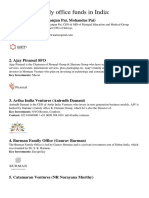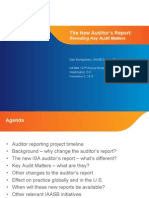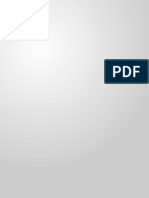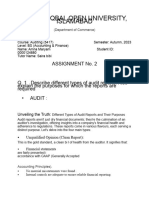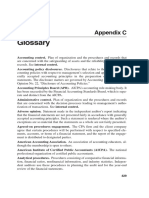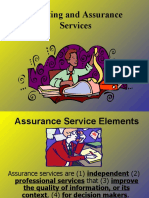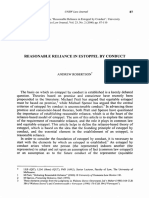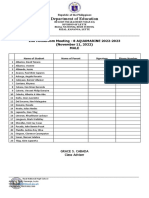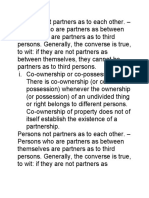Introduction To Auditing Theory
Introduction To Auditing Theory
Uploaded by
TinaChenCopyright:
Available Formats
Introduction To Auditing Theory
Introduction To Auditing Theory
Uploaded by
TinaChenOriginal Title
Copyright
Available Formats
Share this document
Did you find this document useful?
Is this content inappropriate?
Copyright:
Available Formats
Introduction To Auditing Theory
Introduction To Auditing Theory
Uploaded by
TinaChenCopyright:
Available Formats
Boring is not a Canadian Auditing Standard!
Foundation course
Very demanding come prepared!
A note about professionalism
Open door policy
Feedback from past students
Heavy workload
Course structure: starts off theoretical, moves into
application in second half
Midterm: tight for time for a reason!
Questions?
Professional Accounting & Auditing
Organizations
Nature of auditing
Review of types of audits
Activities of public accounting firms
Generally Accepted Auditing Standards
Auditing recommendations and standards
The Auditors Report
5 major bodies in Canada providing a
professional designation:
CICA (CA)
Authority by Canada Business Corporations Act and
provincial acts to set accounting and auditing standards for
pubic accountants.
Assurance Standards Board (Assurance and Related
Services Recommendations)
CICA Handbooks
CGAAC (CGA)
SMAC (CMA)
IIA (CIA)
ISACA (CISA)
Must be information in a verifiable form;
Standards or criteria needed for evaluation
GAAP;
Control criteria such as COSO;
Other best practices
Agreed on in advance
Accumulation and evaluation of evidence about information
Competent, independent person
Auditors report
Economic role: reduces information risk
User(s)
Conclusion
Auditor
Subject
Matter
Accountability
Accountable Party
International Federation of Accountants
Publishes its own recommended international standards on auditing (ISAs)
International Auditing and Assurance Standards Board
CICA has adapted the ISA standards as they are, unless specific
customization is required for the Canadian context.
CASs came into effect for audits of financial statements for periods ending
on or after December 14, 2010
Key focus on harmonization
A handy reference source: http://www.cica.ca/CAS/
Financial statement audits
Compliance audits
Following specific procedures/rules
Operational audits
Evaluates efficiency & effectiveness of ops
Comprehensive audit
3 components (FS audit; compliance audit; value for
money)
Audit report on internal controls (based upon
criteria such as COSO or COCO)
Audits (of historical cost financial statements);
Reviews (less assurance)
Compilation (no assurance)
Special report (opinion on compliance, or on
financial information)
Tax services
Management advisory services
Accounting and bookkeeping services
Practice
standards are general guides
for professional work.
Generally accepted auditing standards
(GAAS).
Assurance standards.
General Standards of Quality Control for
Firms Performing Assurance Engagements.
Quality control standards as reflected in
peer reviews and practice inspections.
GAAS
identify the objectives and key
principles of the financial statement
audit.
GAAS provides a framework under which
all auditing standards are applied.
The objectives and key principles are
found in CAS/ISA 200.
Auditing
standards include Canadian
Audit Practice Statements (CAPSs)
and Audit Guidelines (AuGs).
Standards remain the same over time
and for all audits.
Audit Procedures may vary based on the
organization being audited.
Objective of an audit: to express an opinion on whether
General Standard
financial statements are prepared appropriately in all material
respects. Implies Three-party accountability.
Comply with relevant professional ethical requirements.
Competence; Objectivity; Due Care
Examination Standards
Conduct audit in accordance with CASs, and follow CAS to
determine procedures to be performed.
plan and perform the audit to reduce audit risk; reasonable
assurance
Sufficient understanding of internal controls must be obtained
Sufficient appropriate audit evidence
Reporting standards
Skepticism: attitude of professional scepticism
Identify financial statements
Distinguish between management
&
auditor resp.
Scope of auditor examination
Expression of an opinion on F/Ss, or
state that an opinion cant be
expressed
Do the F/Ss present fairly, in all
material respects
What is an auditors report?
Formats
Standard unqualified auditors report
Unqualified with explanatory wording
Qualified
Adverse/denial
Materiality
Conditions requiring a departure
Primary product of the attestation process
CICA Handbook requires public acct. to commn
nature and extent of involvement with the
information audited.
Concept of association
Requirements for issuing auditors report derived
from GAAS.
Report title
Addressee (must be disclosed: often
shareholders)
Introductory paragraph
Lists the F/Ss, and that they were audited.
Responsibilities: States FSs are resp of
mgmt, and auditors resp is to express an
opinion on them.
Description of an audit: An audit was
performed in accordance with GAAS.
Description of an audit.contd
Factual statement about what the auditor did.
Audit designed to obtain reasonable assurance about
whether the F/Ss are free of material misstatement.
Auditor believes evidence accumulated was appropriate
to express the opinion; Test basis.
Opinion paragraph
The phrase in our opinion professional
judgement.
Opinion on the F/Ss, taken as a whole, and
conclusion about whether company followed an
approp disclosed basis of accounting (usually
GAAP).
Dont blindly rely on GAAP look @ substance of
transaction
presents fairly auditor cannot check every
transaction!
Name of public accounting
Place of issue
Auditors report date
firm
Completion date, not date of substantial
completion.
No earlier than when sufficient
appropriate audit evidence obtained.
After those with recognized authority
(such as the board) have approved the
F/Ss.
INDEPENDENT AUDITOR'S REPORT
[Appropriate Addressee]
Report on the Financial Statements
We have audited the accompanying financial statements of ABC
Company, which comprise the statement of financial position as at
December 31, 20X1, and the statement of comprehensive income,
statement of changes in equity and statement of cash flows for the
year then ended, and a summary of significant accounting policies
and other explanatory information.
Management's Responsibility for the Financial Statements
Management is responsible for the preparation and fair
presentation of these financial statements in accordance with
International Financial Reporting Standards, and for such internal
control as management determines is necessary to enable the
preparation of financial statements that are free from material
misstatement, whether due to fraud or error.
Auditor's Responsibility
Our responsibility is to express an opinion on these financial statements
based on our audit. We conducted our audit in accordance with Canadian
generally accepted auditing standards. Those standards require that we
comply with ethical requirements and plan and perform the audit to obtain
reasonable assurance about whether the financial statements are free from
material misstatement.
An audit involves performing procedures to obtain audit evidence about
the amounts and disclosures in the financial statements. The procedures
selected depend on the auditor's judgment, including the assessment of the
risks of material misstatement of the financial statements, whether due to
fraud or error. In making those risk assessments, the auditor considers internal
control relevant to the entity's preparation and fair presentation of the financial
statements in order to design audit procedures that are appropriate in the
circumstances, but not for the purpose of expressing an opinion on the
effectiveness of the entity's internal control. An audit also includes evaluating
the appropriateness of accounting policies used and the reasonableness of
accounting estimates made by management, as well as evaluating the overall
presentation of the financial statements.
We believe that the audit evidence we have obtained is sufficient
and appropriate to provide a basis for our audit opinion.
Opinion
In our opinion, the financial statements present fairly, in all
material respects, the financial position of ABC Company as at
December 31, 20X1, and its financial performance and its cash
flows for the year then ended in accordance with International
Financial Reporting Standards.
Report on Other Legal and Regulatory Requirements
[Form and content of this section of the auditor's report will
vary depending on the nature of the auditor's other reporting
responsibilities.]
[Auditor's signature]
[Date of the auditor's report]
[Auditor's address]
Expanded reporting options under CAS
Emphasis of matters paragraph (such as going concern
or change in accounting policy). Appropriately presented
in the financial statements, but needs to be drawn to the
users attention.
Typically:
Consistency (of accounting principles applied)
Accounting Uncertainty
Emphasis
Going Concern
Preceeds the opinion paragraph.
Other matters paragraph (matters other than those
presented or disclosed in the FSs)
Only where:
Scope limitation, but restriction confined to a
specific area;
GAAP departure: effect can be quantified or
isolated
If the condition being reported on is very
material Adverse opinion.
Auditor must either use the term except
for, or except that, or except as.
Fairly rare.
[TO FOLLOW SECTION ON AUDITOR RESPONSIBILITES]
Basis for Qualified Opinion
The company's inventories are carried in the statement of financial
position at xxx. Management has not stated the inventories at the lower of
cost and net realizable value but has stated them solely at cost, which
constitutes a departure from International Financial Reporting Standards.
The company's records indicate that had management stated the
inventories at the lower of cost and net realizable value, an amount of xxx
would have been required to write the inventories down to their net
realizable value. Accordingly, cost of sales would have been increased by
xxx, and income tax, net income and shareholders' equity would have been
reduced by xxx, xxx and xxx, respectively.
Qualified Opinion
In our opinion, except for the effects of the matter described in the
Basis for Qualified Opinion paragraph, the financial statements present
fairly, in all material respects, the financial position of ABC Company as at
December 31, 20X1, and its financial performance and its cash flows for the
year then ended in accordance with International Financial Reporting
Standards.
Overall F/Ss are SO materially
misstated or misleading that they do
not present fairly the financial
position, results of operation, or
changes in cash flow in accordance
with GAAP.
[TO FOLLOW SECTION ON AUDITOR RESPONSIBILITES]
Basis for Adverse Opinion
As explained in Note X, the company has not consolidated the financial
statements of subsidiary XYZ Company it acquired during 20X1 because it
has not yet been able to ascertain the fair values of certain of the
subsidiary's material assets and liabilities at the acquisition date. This
investment is therefore accounted for on a cost basis. Under International
Financial Reporting Standards, the subsidiary should have been consolidated
because it is controlled by the company. Had XYZ been consolidated, many
elements in the accompanying financial statements would have been
materially affected. The effects on the consolidated financial statements of
the failure to consolidate have not been determined.
Adverse Opinion
In our opinion, because of the significance of the matter discussed in
the Basis for Adverse Opinion paragraph, the consolidated financial
statements do not present fairly the financial position of ABC Company and
its subsidiaries as at December 31, 20X1, and their financial performance
and their cash flows for the year then ended in accordance with
International Financial Reporting Standards.
Auditor
is unable to satisfy
himself/herself that the overall F/Ss
are fairly presented.
Often arises due to severe limitation
on scope.
Can only arise from a lack of
knowledge by the auditor about
whether or not the F/Ss are fairly
stated.
Basis for Disclaimer of Opinion
The company's investment in its joint venture XYZ (Country X)
Company is carried at xxx on the company's statement of financial
position, which represents over 90% of the company's net assets as at
December 31, 20X1. We were not allowed access to the management and
the auditors of XYZ, including XYZ's auditors' audit documentation. As a
result, we were unable to determine whether any adjustments were
necessary in respect of the company's proportional share of XYZ's assets
that it controls jointly, its proportional share of XYZ's liabilities for which it
is jointly responsible, its proportional share of XYZ's income and expenses
for the year, and the elements making up the statement of changes in
equity and statement of cash flows.
Disclaimer of Opinion
Because of the significance of the matter described in the Basis for
Disclaimer of Opinion paragraph, we have not been able to obtain
sufficient appropriate audit evidence to provide a basis for an audit
opinion. Accordingly, we do not express an opinion on the financial
statements.
Auditors scope has been restricted
Caused by client vs beyond control of auditor or client
Effect on auditor report the same, but diff interpretations
of materiality
Client imposed: mgmt trying to prevent discovery of
misstmt? Likely denial of opinion.
If beyond clients control: either qualification of scope or
opinion.
Reservation paragraph needed to describe restriction.
Statements not in conformity with GAAP
A qualified or adverse opinion depending on materiality
and pervasiveness.
If more than once condition requiring qualification qualify
opinion for each condition.
Report involving reliance on another auditor
Primary auditor takes resp for the opinion;
Primary auditor must assess secondary auditors qualifications,
competence and integrity;
If a qualified or denial of opinion is necessary due to inability to
rely on secondary auditors work the secondary auditor may
be named.
Negative assurance: inappropriate
Nothing came to our attention that would lead us to
question
Essential for determining appropriate type of
audit report to issue;
Pervasiveness of scope limitation or GAAP
departure must also be considered.
Would the decision of a person who is relying on
the F/Ss be changed???
If material, but does not overshadow F/Ss as a
whole, qualified.
qualified
If amounts material and pervasive: auditor must
issue a denial of opinion or adverse opinion.
GAAP departure
Misstmts must be compared with a measurement base
before materiality decision can be made
% of net income before taxes, total assets, current
assets, etc.
Consider combined effect of all unadjusted errors.
SAD
If measurability uncertain: must disclose this.
Scope Limitation
Look at the size of potential misstmts.
Required to be added to the audited financial statements
by SOX;
Limited to internal controls over financial reporting
Controls related to the accuracy of accounting/ recordkeeping,
and safeguarding of assets
Typically performed as part of the audit engagement.
These controls do NOT guarantee the financial statements
are free of material misstatement. Current evaluation will
not necessarily apply to the future.
Conformity with an established criteria must be referenced,
as well as concepts of materiality and a fairly stated
management assessment.
Management:
Sound accounting policies
Maintaining adequate internal controls
Making fair representations in the F/Ss
Stated right in annual report
Auditors
Perform audit with an attitude of professional
skepticism
Seek reasonable assurance, not absolute
assurance
Responsibilities relating to errors, frauds or
other irregularities?
Decision to accept or retain the client
Understand the clients business
Plan and design audit approach
Aim: sufficient, appropriate audit evidence; minimize cost of
accumulating evidence
Understand clients internal controls and assess risk
Required by examination standard ii of GAAS
Allows auditor to evaluate how effective controls will be in preventing and
detecting errors, frauds, or irregularities
Perform the audit tests and evaluate results
Perform test of controls
If control risk assessed below maximum, auditor can reduce the extent to
which accuracy of F/S amounts related to these controls must be validated;
Substantive procedures (analytical and tests of details and balances)
Analytical procedures: assess overall reasonableness of transactions or
balances
Tests of details: specific procedures testing for monetary misstatement
Form an opinion and issue audit report
You might also like
- Trustee Instructions: Part I Managing Your Living TrustDocument38 pagesTrustee Instructions: Part I Managing Your Living Trust:Nikolaj: Færch.82% (11)
- The Single Family Office Funds in IndiaDocument4 pagesThe Single Family Office Funds in IndiagandhiannexNo ratings yet
- Ball Handling Mastery Training ManualDocument32 pagesBall Handling Mastery Training ManualTitus BaldwinNo ratings yet
- Lambers Cpa Review AuditDocument589 pagesLambers Cpa Review AuditZedge100% (4)
- SESI 10 ch17 - External Auditing Function - LectureDocument109 pagesSESI 10 ch17 - External Auditing Function - LecturekimkimberlyNo ratings yet
- T07 - CGA MB Understanding Audit Review ComDocument6 pagesT07 - CGA MB Understanding Audit Review ComWenli FuNo ratings yet
- Presentation Chapter 9Document63 pagesPresentation Chapter 9Sitti NajwaNo ratings yet
- Professional Standards: Mcgraw-Hill/IrwinDocument41 pagesProfessional Standards: Mcgraw-Hill/IrwinJay-ar PreNo ratings yet
- 17the Auditor's ReportDocument8 pages17the Auditor's ReportIrish SanchezNo ratings yet
- AUD Notes Chapter 1Document14 pagesAUD Notes Chapter 1janell184100% (1)
- Audit Report of CompaniesDocument7 pagesAudit Report of CompaniesPontuChowdhuryNo ratings yet
- The New Auditor's Report:: Revealing Key Audit MattersDocument18 pagesThe New Auditor's Report:: Revealing Key Audit MattersMai Rosaupan100% (1)
- W Y R N K: HAT OU Eally Eed To NOWDocument3 pagesW Y R N K: HAT OU Eally Eed To NOWJoey LinNo ratings yet
- Week 1Document19 pagesWeek 1Kashif GulzarNo ratings yet
- Financial Statement AuditDocument43 pagesFinancial Statement AuditMahmudul HasanNo ratings yet
- PWC Understanding Financial Statement AuditDocument18 pagesPWC Understanding Financial Statement AuditAries BautistaNo ratings yet
- Gaap and AuditDocument35 pagesGaap and AuditAayushi Arora100% (1)
- AA - Spring 2021 2 Client AcceptanceDocument27 pagesAA - Spring 2021 2 Client AcceptanceSarim Ahmad100% (1)
- Audit Opinions and ReportsDocument10 pagesAudit Opinions and ReportsaitaasamkNo ratings yet
- ABS-LECTURE 1 (Nature & Issues of Audit)Document57 pagesABS-LECTURE 1 (Nature & Issues of Audit)Lordwin ArcherNo ratings yet
- Audit ReportDocument6 pagesAudit ReportPoonam SuryawanshiNo ratings yet
- 1audit-An OverviewDocument68 pages1audit-An Overviewquenashel2013No ratings yet
- Concept of True & FairDocument7 pagesConcept of True & Fairyogiraj28No ratings yet
- Chapt 1Document22 pagesChapt 1Sidra SwatiNo ratings yet
- Advanced AuidtingDocument321 pagesAdvanced AuidtingAlexis ParrisNo ratings yet
- Engagement Essentials: Preparation, Compilation, and Review of Financial StatementsFrom EverandEngagement Essentials: Preparation, Compilation, and Review of Financial StatementsNo ratings yet
- AC414 - Audit and Investigations II - Introduction To Audit EvidenceDocument32 pagesAC414 - Audit and Investigations II - Introduction To Audit EvidenceTsitsi AbigailNo ratings yet
- 08 Audit Khidmat Pengesahan, Insuran Dan Tanggungjawab Selepas AuditDocument45 pages08 Audit Khidmat Pengesahan, Insuran Dan Tanggungjawab Selepas Auditathirah jamaludinNo ratings yet
- Annual Update and Practice Issues for Preparation, Compilation, and Review EngagementsFrom EverandAnnual Update and Practice Issues for Preparation, Compilation, and Review EngagementsNo ratings yet
- Untitled Document 50Document13 pagesUntitled Document 50waleedkhan567799No ratings yet
- Planning and Conducting AuditaDocument12 pagesPlanning and Conducting AuditaJc QuismundoNo ratings yet
- Nama:Annisa Wijayanti Npm:185401Document22 pagesNama:Annisa Wijayanti Npm:185401annisa wijayantiNo ratings yet
- Chapt 1Document63 pagesChapt 1Dinaol TeshomeNo ratings yet
- GlossoryDocument8 pagesGlossoryromindersNo ratings yet
- Inf Auditoria InglesDocument9 pagesInf Auditoria Inglescontabilidad2No ratings yet
- 2022 TOPIC 2 - Regulation of AuditingDocument33 pages2022 TOPIC 2 - Regulation of AuditingIanNo ratings yet
- Introduction To Audit Services and Financial Statements AuditDocument35 pagesIntroduction To Audit Services and Financial Statements AuditBryzan Dela CruzNo ratings yet
- Audit-Report SampleDocument2 pagesAudit-Report SamplesyrexdestroyerNo ratings yet
- Account StandardsDocument13 pagesAccount StandardsPooja BaghelNo ratings yet
- Module For Value EdDocument38 pagesModule For Value EdJoyce Ann CortezNo ratings yet
- 4427template of Modified Auditors Report For Company in BangladeshDocument19 pages4427template of Modified Auditors Report For Company in BangladeshSalahuddin KhaledNo ratings yet
- Acca P6 QuestionDocument8 pagesAcca P6 QuestionChuaJieLingNo ratings yet
- ISA 540 Revised Audit Client Briefing Final BrandingDocument11 pagesISA 540 Revised Audit Client Briefing Final Brandingatomicslash3No ratings yet
- PPTDocument5 pagesPPTStarNo ratings yet
- External AuditDocument26 pagesExternal Auditjuju1992No ratings yet
- AUDITING MIDTERM CompressedDocument122 pagesAUDITING MIDTERM Compressedcyrus.sargento.cbaNo ratings yet
- Advanced Auditing-Lecture 1, Assurance and Attestation Services - Date 10-10-2013Document30 pagesAdvanced Auditing-Lecture 1, Assurance and Attestation Services - Date 10-10-2013mostafakhaled333No ratings yet
- 12-18 AuditDocument15 pages12-18 AuditAvinash KumarNo ratings yet
- Udit Eports: Prepared by Saba BanoDocument26 pagesUdit Eports: Prepared by Saba BanoMogiee MooNo ratings yet
- Modern Auditing 7th Edition: William C. Boynton Raymond N. Johnson Walter G. KellDocument45 pagesModern Auditing 7th Edition: William C. Boynton Raymond N. Johnson Walter G. KellRizky ZulmiNo ratings yet
- A Report On Audit Planning of ACI LIMITEDDocument33 pagesA Report On Audit Planning of ACI LIMITEDAtiaTahiraNo ratings yet
- Chapter Five: Audit of Governmental and Not For Profit OrganizationsDocument34 pagesChapter Five: Audit of Governmental and Not For Profit OrganizationsKetema AsfawNo ratings yet
- Lesson 1 An Introduction To AuditingDocument7 pagesLesson 1 An Introduction To AuditingGrace RepradoNo ratings yet
- Auditing Assurance ServicesDocument24 pagesAuditing Assurance ServicesMicaela Marimla100% (1)
- Principles of Auditing-1Document7 pagesPrinciples of Auditing-1Ken BiiNo ratings yet
- Module 1 Audit An OverviewDocument27 pagesModule 1 Audit An OverviewGONZALES, MICA ANGEL A.No ratings yet
- What Is An Audit ReportDocument7 pagesWhat Is An Audit ReportRyoma EchizenNo ratings yet
- Accounting For Managers: A CknowledgmentDocument16 pagesAccounting For Managers: A CknowledgmentMUHAMMAD NABEELNo ratings yet
- Audit Report and OpinionDocument6 pagesAudit Report and Opinionspilled seasonNo ratings yet
- Class-2 SA-200Document5 pagesClass-2 SA-200kunal3152No ratings yet
- Limitations To Financial Statement AnalysisDocument4 pagesLimitations To Financial Statement Analysissangya01No ratings yet
- Principles of Audit and AssuranceDocument20 pagesPrinciples of Audit and AssuranceUnique OfficialsNo ratings yet
- Introduction To Audit Services and Financial Statements AuditDocument35 pagesIntroduction To Audit Services and Financial Statements AuditBryzan Dela CruzNo ratings yet
- Reasonable Reliance in Estoppel by Conduct - Andrew RobertsonDocument24 pagesReasonable Reliance in Estoppel by Conduct - Andrew RobertsondanielNo ratings yet
- Ortega vs. Court of Appeals, 245 SCRA 529Document6 pagesOrtega vs. Court of Appeals, 245 SCRA 529Santiago Tiongco100% (1)
- Overcurrent Coordination Basics ConductorsDocument7 pagesOvercurrent Coordination Basics ConductorsrobertoseniorNo ratings yet
- NRWB v. A.L. Ang Network Inc.Document9 pagesNRWB v. A.L. Ang Network Inc.EnarftedNo ratings yet
- Despiece Polipasto Manual CycloneDocument40 pagesDespiece Polipasto Manual CyclonearmandoNo ratings yet
- IIX1328WOGF4421Document2 pagesIIX1328WOGF4421agarb20No ratings yet
- Petito Doc 2Document2 pagesPetito Doc 2Melissa RatliffNo ratings yet
- A Report On An Automated Whistle Blowing System For Aiding Crime InvestigationDocument68 pagesA Report On An Automated Whistle Blowing System For Aiding Crime InvestigationXavier Francis S. LutaloNo ratings yet
- Mode D'emploi Creative Muvo 2C (Français - 2 Des Pages)Document2 pagesMode D'emploi Creative Muvo 2C (Français - 2 Des Pages)hbadji2024No ratings yet
- Deed of Absolute Sale: Vendor VendeeDocument2 pagesDeed of Absolute Sale: Vendor VendeeJudah PascoNo ratings yet
- SAP Erp4students Courses For Students of RCYCIDocument1 pageSAP Erp4students Courses For Students of RCYCIEyad KamakhiNo ratings yet
- Letter For Submit Proposal Speaker CornerDocument2 pagesLetter For Submit Proposal Speaker CornerbloggerfordummiesNo ratings yet
- Attendance Sheet For Parents' MeetingDocument4 pagesAttendance Sheet For Parents' Meetinggrace cabadaNo ratings yet
- LA2008 Administrative Law Pre-Exam Update 2021: Chapter 5: The Nature of Judicial ReviewDocument3 pagesLA2008 Administrative Law Pre-Exam Update 2021: Chapter 5: The Nature of Judicial ReviewAkbar ShoroNo ratings yet
- Philippine Phoenix V Woodworks PDFDocument5 pagesPhilippine Phoenix V Woodworks PDFRobert LastrillaNo ratings yet
- List of Iconic CPG Projects in SingaporeDocument2 pagesList of Iconic CPG Projects in SingaporeKS LeeNo ratings yet
- Joseph: The Testament ofDocument8 pagesJoseph: The Testament ofKelvin WilsonNo ratings yet
- GAD Club Action Plans, Officers & by LawsDocument5 pagesGAD Club Action Plans, Officers & by Lawsbornthisway52311No ratings yet
- Persons Not Partners As To Each OtherDocument6 pagesPersons Not Partners As To Each OtherBisag AsaNo ratings yet
- Voir Dire Proposed QuestionsDocument4 pagesVoir Dire Proposed Questionsauden5No ratings yet
- Eu Accession Process ClustersDocument2 pagesEu Accession Process ClustersgiorgiNo ratings yet
- CSAsubscriptionDocument2 pagesCSAsubscriptionshekharkumar3221No ratings yet
- 639 2659 1 PBDocument18 pages639 2659 1 PBachilokodavidNo ratings yet
- Why Do White Americans Support The Death Penalty?Document25 pagesWhy Do White Americans Support The Death Penalty?Scott Cobb100% (1)
- Loan AgreementDocument3 pagesLoan AgreementbeldiansitsolutionsNo ratings yet
- Letter-1 To Principal of BVM-20 MarDocument4 pagesLetter-1 To Principal of BVM-20 Marveeru1312No ratings yet
- Kualitas Es Krim Bayam Merah (Alternanthera Amoena Voss.) Dengan Penstabil Pasta Ekstrak Albedo Kulit Jeruk BaliDocument14 pagesKualitas Es Krim Bayam Merah (Alternanthera Amoena Voss.) Dengan Penstabil Pasta Ekstrak Albedo Kulit Jeruk BaliRahasia KeciNo ratings yet

